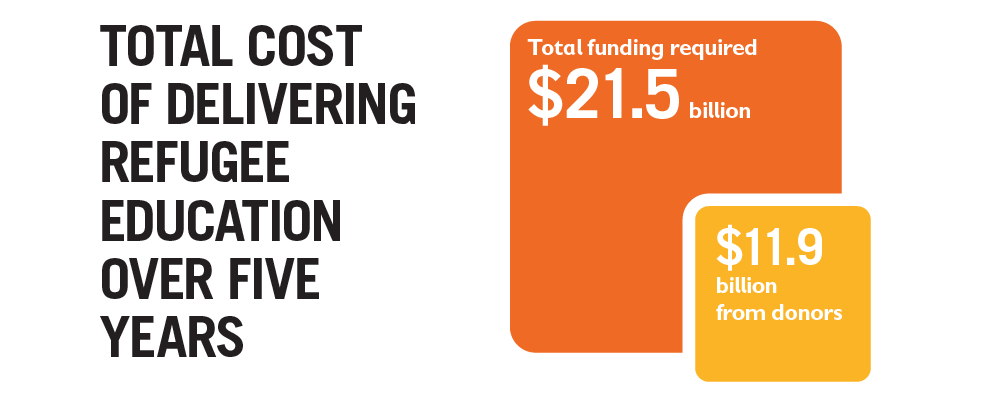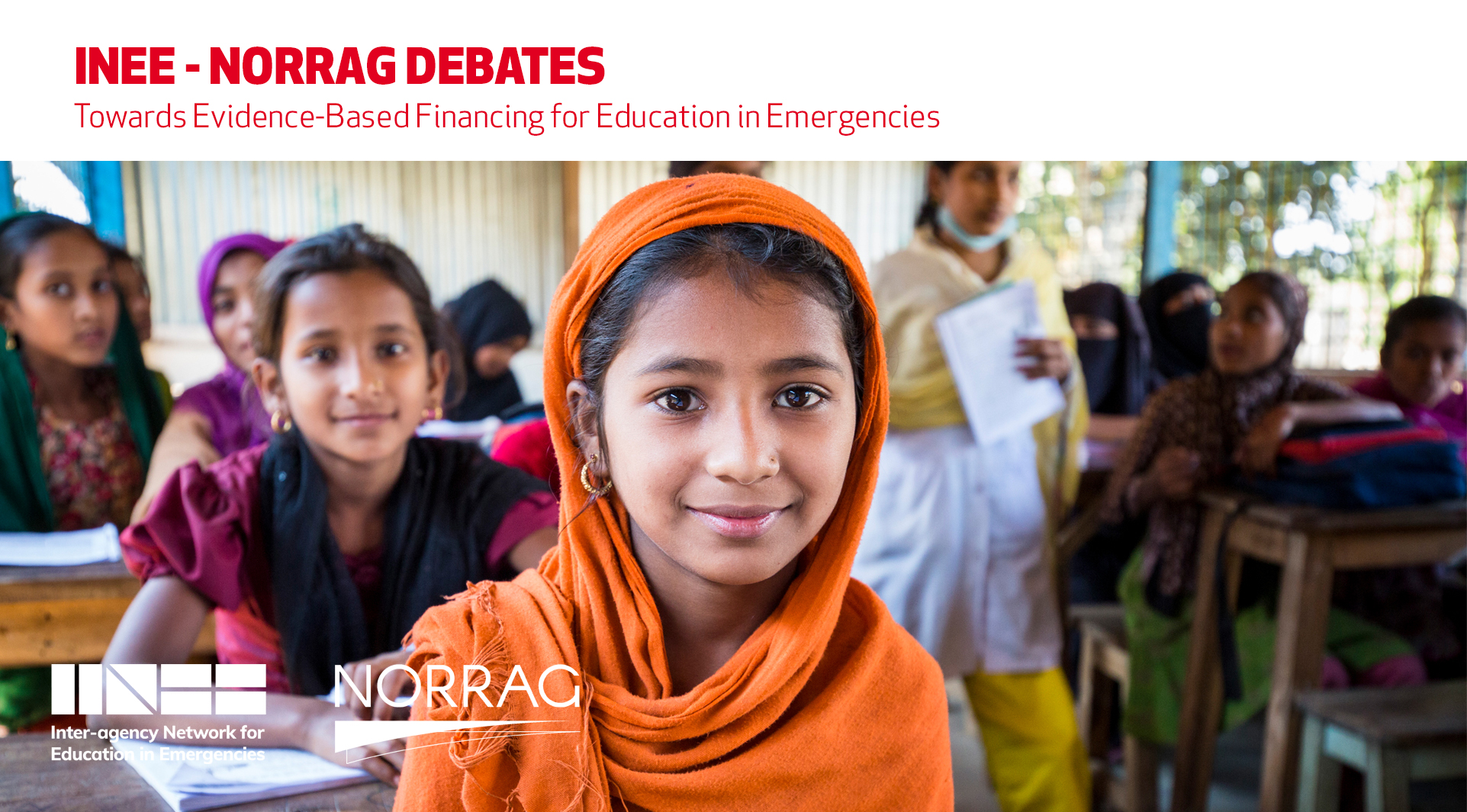Time to act: Calculating & securing the finances to fund education for the world’s refugees
This post is published as part of the debate series: Towards Evidence-Based Financing for Education in Emergencies, by NORRAG and INEE, intended to promote discussion of and explore the linkages between financing and evidence for education in emergencies (EiE). In this post, the author discusses a global plan to finance refugee education.
Emma Wagner is Education in Emergencies, Policy and Advocacy Adviser at Save the Children. She sits on the INEE Advocacy Working Group and is a member of the Global Campaign for Education and the civil society group for the Education Cannot Wait Fund.
The refugee education crisis
As a result of discrimination, exclusion and a lack of funding, refugee children are five times less likely to attend school than other children in the countries to which they have moved. Only 61 per cent attend primary and 22 per cent access secondary school, compared to global averages of 91 per cent and 84 per cent respectively.
There are many incontestable reasons why the international community must act to right this wrong. There are more refugees now than at any time in history. A child’s right to an education doesn’t end in times of emergency. Refugees have a critical need for safe, good quality and inclusive education – their building block to recovery, resilience and long-term development.
Furthermore, refugee children and their families consistently identify education as a high priority. As actors involved in programming and advocacy across the humanitarian development divide, we must ensure we listen to what refugees say they need and act upon their wishes.
With 3.7 million refugee boys and girls currently out of school, and those that are in school, often struggling in poor learning environments, it’s right to feel depressed. But in recent years we have seen new commitments – New York Declaration, Grand Bargain and the forthcoming Global Compact on Refugees – which give us hope.
The need for a global plan to deliver education to refugees
But commitments without actionable plans, rarely deliver results. And these children and youth cannot afford more prevarication on the part of governments and international agencies.
That’s why Save the Children’s new report, Time to act: A costed plan to deliver quality education to every last refugee child, challenges governments and international agencies to deliver on their promises with practical action to close the refugee education gap. It sets out the need for a global plan of action that could deliver quality education to the 7.5 million refugees who are school age (3-18 years).
We have identified three pillars on which the plan should be based:
- Inclusion: support for including refugees in national education systems;
- Improvement: increasing efforts to ensure children are learning;
- Investment: mobilising the funding necessary to scale up access to quality learning opportunities for refugees.
This blog will focus on the investment element of our proposed plan.
More & better funding required
As the opening blog in this series explains, international humanitarian funding allocated to education is not sufficient to support the unprecedented need of children in crisis contexts. Financing for refugee education frequently falls between the false divide of humanitarian and development programming. It’s often short-term, earmarked for projects that do not reflect refugees’ complex educational needs, and suffers from highly fragmented planning.
85 percent of the world’s refugees live in low and middle-income countries, whose education systems already struggle to meet the needs of the most marginalised. These countries need international support to scale up education services and provide alternative educational opportunities for refugees – through the principle of responsibility sharing, agreed in the New York Declaration.
But how do we develop a global understanding of what financing is needed to fund refugee education, what proportion should come from the international community and through what mechanisms?
Save the Children has developed costing and adjoining recommendations to get this global conversation started.
Calculating the cost
Based on plausible costs and credible policy options, we estimate that $21.5 billion would deliver quality universal pre-primary, primary, and secondary education to the world’s 7.5 million school-age refugees, over five years — or $575 per child per year.

Countries hosting refugees perform a global public good for the international community as a whole and should be supported in doing so. However, not all countries require the same level of support, so our costings propose different levels of support for refugee education, in line with national capacity.
Low-income countries receive 95 percent of the required amount, lower-middle-income countries 80 percent, and upper-middle-income countries 40 percent.
Applying this formula, $11.9 billion would be needed in international assistance, or $4.3 billion per year. To put this into perspective, the 2018 World Cup cost $11 billion US to stage, so although the figures look large, they represent a relatively modest investment which could reap massive benefits.

Funding opportunities
Recently we’ve seen encouraging examples of an increase in support to education in emergencies and education for refugees in particular. The European Union has steadily increased its humanitarian funding for education – 8 percent is earmarked for education from the humanitarian budget in 2018, rising to 10 percent in 2019. This is strongly welcomed.
Furthermore, there are increasing opportunities to secure the funding necessary to realise the global plan. These include:
- the Global Partnership for Education;
- the Education Cannot Wait Fund;
- the World Bank’s Sub-Window for Refugees;
- the proposed International Financing Facility for Education;
- and of course, bilateral assistance.
Our report sets out several recommendations for each of these funding opportunities.
Delivering the promise
Our report shows that it’s well within our means to provide a quality education to every last refugee child. We urge governments and international organisations to use the unique opportunity of the Global Compact on Refugees to agree on a global costed plan designed to deliver a transformation in education for refugees. The time to act is now.
Photo credits: UNHCR/Roger Arnold
++++
Ways to engage
- Write a blog post on the topic. Contacts: Sonja Anderson (INEE) sonja.anderson@inee.org
- Comment and discuss with the authors and other readers.
- Share the blog posts with your colleagues and networks.
For more information, contact blog@norrag.org or blog@inee.org.
NORRAG is a global membership-based network of international policies and cooperation in education, established in 1986. NORRAG’s core mandate and strength is to produce, disseminate and broker critical knowledge and to build capacity among the wide range of stakeholders who constitute its network. NORRAG contributes to enhancing the conditions for participatory, informed, and evidence-based policy decisions that improve equity and quality of education. Learn more at www.norrag.org
INEE is an open, global network of UN agencies, NGOs, donors, governments, universities, schools, and affected populations working together to ensure all persons the right to quality education in emergencies. Founded in 2000, INEE serves its members through community building, convening diverse stakeholders, knowledge management, advocating and amplifying ideas and knowledge, facilitating collective action, and providing members with resources and support. Learn more at www.inee.org.
Disclaimer: Both NORRAG and INEE offer spaces for dialogue about issues, research, and opinion on education and development. The views and factual claims made in the posts in this joint NORRAG-INEE blog series are the responsibility of their authors and are not necessarily representative of NORRAG’s or INEE’s opinions, policy, or activities.


Pingback : NORRAG – Towards Evidence-Based Financing for Education in Emergencies - NORRAG -